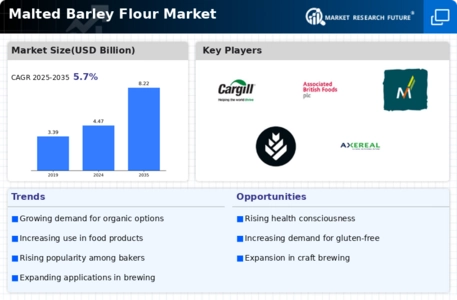Adoption of Clean Label Products
The clean label movement, characterized by transparency in ingredient sourcing and production processes, is gaining momentum among consumers. The Malted Barley Flour Market is responding to this demand by offering products that are free from artificial additives and preservatives. As consumers increasingly seek products with recognizable ingredients, malted barley flour is well-positioned to meet these expectations. Recent surveys indicate that over 60% of consumers prefer clean label products, which is likely to influence purchasing decisions. This trend not only enhances consumer trust but also drives innovation in product development within the Malted Barley Flour Market, as manufacturers strive to align with consumer preferences for clean and natural ingredients.
Expansion of Craft Brewing Sector
The craft brewing sector has experienced remarkable growth, contributing to the demand for malted barley flour. As craft breweries continue to proliferate, the need for high-quality ingredients, including malted barley, becomes paramount. The Malted Barley Flour Market is poised to benefit from this trend, as brewers seek to enhance the flavor profiles of their products. Recent data indicates that the craft beer market has expanded by approximately 20% over the past few years, with malted barley being a key ingredient. This surge in craft brewing not only drives demand for malted barley flour but also encourages innovation in product formulations, further solidifying its position in the Malted Barley Flour Market.
Growing Popularity of Plant-Based Diets
The rising popularity of plant-based diets is reshaping consumer preferences and driving demand for plant-derived ingredients. The Malted Barley Flour Market is experiencing a surge in interest as consumers seek alternatives to traditional flour sources. This shift is supported by a growing body of research highlighting the health benefits of plant-based diets, including improved heart health and weight management. Market data suggests that the plant-based food sector is expected to grow at a rate of approximately 10% annually. As a result, malted barley flour, with its nutritional profile and versatility, is likely to become a favored ingredient among those adopting plant-based lifestyles, thereby propelling growth in the Malted Barley Flour Market.
Increased Use in Nutritional Supplements
The growing emphasis on health and nutrition has led to an increased incorporation of malted barley flour in nutritional supplements. This trend is particularly evident in the Malted Barley Flour Market, where manufacturers are exploring its potential health benefits, such as improved digestion and enhanced energy levels. The market for nutritional supplements is projected to reach substantial figures, with estimates suggesting a growth rate of around 8% annually. As consumers become more health-conscious, the demand for functional ingredients like malted barley flour is likely to rise, positioning it as a vital component in the Malted Barley Flour Market. This shift reflects a broader trend towards holistic health and wellness.
Rising Demand for Gluten-Free Alternatives
The increasing prevalence of gluten intolerance and celiac disease has led to a notable rise in demand for gluten-free products. Malted Barley Flour Market is witnessing a shift as consumers seek alternatives that cater to their dietary restrictions. This trend is further supported by a growing awareness of health and wellness, prompting manufacturers to innovate gluten-free offerings. The market for gluten-free products is projected to expand significantly, with estimates suggesting a compound annual growth rate of over 10% in the coming years. As a result, malted barley flour, known for its potential gluten-free properties, is likely to gain traction among health-conscious consumers, thereby driving growth in the Malted Barley Flour Market.
















Leave a Comment